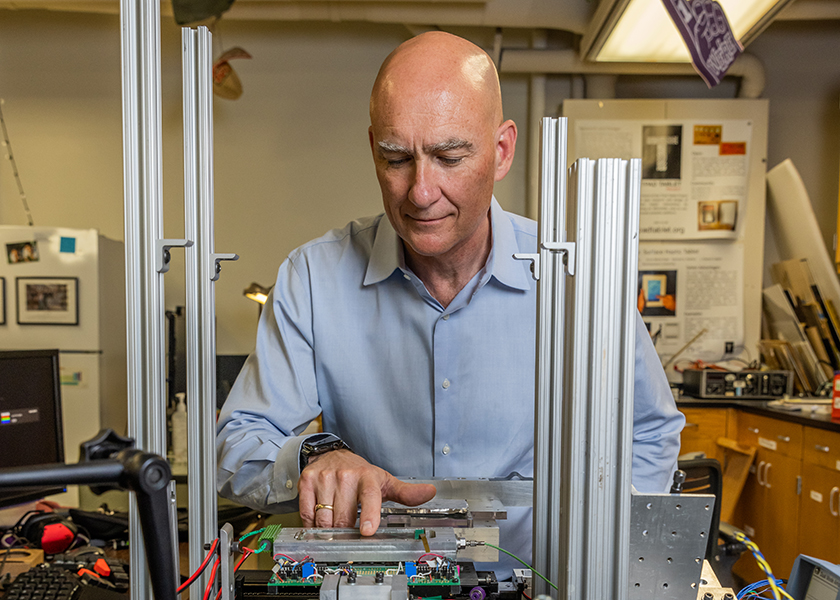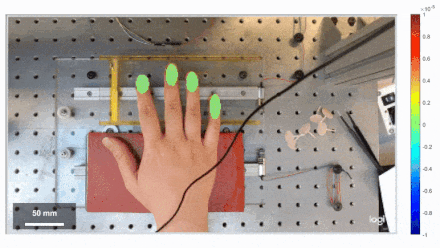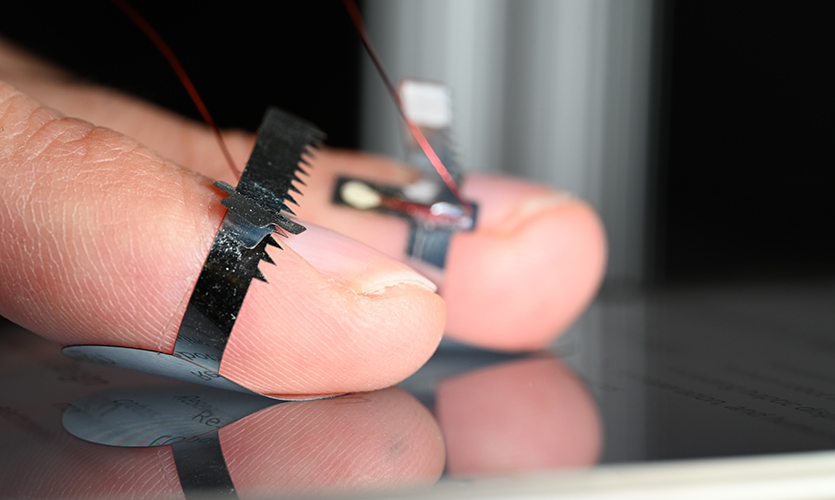The Problem
Reasons behind the failure of electroadhesive clutches was not fully understood.
Reasons behind the failure of electroadhesive clutches was not fully understood.
Redesigning the clutch with a multilayer structure that includes a soft interlayer to help spread out the stress more evenly.
Improved electroadhesive clutches could support improved robotics and wearable devices in healthcare.
Professor J. Edward Colgate, Postdoctoral researcher Bekir Aksoy
Electroadhesive (EA) clutches work similarly to car clutches, but instead of mechanical pressure, they use electrical voltage to engage and disengage, making them lightweight and fast. These advantages make them ideal for smaller machines mobile robotics, wearable devices, and even human-computer interfaces.
A new study from Northwestern Engineering’s J. Edward Colgate and his team could optimize their performance to make these burgeoning technologies even more robust and efficient.
"These clutches have been around for a while, but we wanted to really understand what causes them to fail and how we can make them stronger and more efficient," said Colgate, Walter P. Murphy Professor of Mechanical Engineering. "Our focus was on improving their performance at low operating voltages, which is crucial for robotics and wearable devices."

The team presented its work in the paper “High Performance Electroadhesive Clutches with Multilayered Architecture,” published Feb. 14 in the journal Science Advances. Colgate was the paper’s corresponding author, while Bekir Aksoy, a postdoctoral researcher at the Center for Robotics and Biosystems, was the paper’s first author.
While EA clutches offer unique benefits to robotics and human-computer interfaces, one of their biggest shortcomings has been their failure due to uneven force distribution when engaged.
To solve this, the team used advanced imaging techniques to monitor the clutch under stress. They made one side of the clutch transparent, allowing them to observe how it deformed and eventually failed. The team found that when the clutch was engaged, stress would build unevenly across its surface, leading to cracks and peeling at critical points.
"We found that the failure often happened because the force wasn’t distributed evenly across the surface," Aksoy said. "We redesigned the clutch with a multilayer structure that included a soft interlayer to help spread out the stress more evenly."

The new design reduced stress on the front side, but caused peeling at the back. To address this, the team extended the adhesion layer beyond the interlayer, creating a "tail" that gradually distributed the stress, preventing peeling.
This redesign resulted in a clutch that held 22 Newtons of force over a 1 cm² area at just 100 volts — more force per voltage than any similar device currently on the market. Unlike traditional clutches that rely on slipping mechanisms, the design uses the deformation of the soft layer to transmit force, eliminating friction-related energy loss and improving overall energy efficiency.
“This is a big step forward,” Aksoy said. “Not only have we improved the clutch's force output, but we've also made it more energy efficient, which is crucial for applications where low power consumption is important.”
One promising application is a wearable device for finger rehabilitation developed in Colgate’s lab. Weighing only 28 milligrams, the ring-shaped device provides controlled resistance for muscle training, which could aid people recovering from conditions such as stroke, arthritis, and Parkinson’s disease.

Safe and lightweight, the exercise device was designed to help with hand rehabilitation by specifically targeting interossei muscles in the hand. The device includes ultra-light rings, each weighing just 28 milligrams that function similarly to multilayered EA clutches.
To test how well the device helps stretch these muscles, the team conducted an experiment with 10 participants. Each participant wore the EA rings on their index, middle, ring, and pinky fingers. They placed their fingers on a smooth, movable glass surface while resting their palm on a soft rubber pad for comfort. A motor gently moved the glass sideways, and when one of the rings was activated, the corresponding finger stuck to the moving surface. This created a stretch between the active and inactive fingers, gently working the hand muscles with minimal effort.
Beyond rehabilitation, the EA clutch could also enhance virtual reality (VR) and augmented reality (AR) experiences. The lightweight, flexible nature of the clutch makes it ideal for providing haptic feedback in VR and AR environments, giving users a more immersive and responsive experience. It could also improve force control in advanced robotics, making robots more adaptable and capable of performing complex tasks.
"Although we're still in the early stages, the potential for this technology is enormous," Aksoy said. "We’re excited to continue refining the clutch and exploring its applications in robotics, healthcare, and consumer devices."